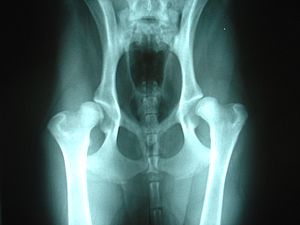Hip dysplasia facts for kids
Hip dysplasia is a condition where a dog's hip joint doesn't grow correctly. Imagine a ball and socket joint, like your shoulder or hip. In a healthy hip, the ball (the top of the leg bone) fits snugly into the socket (a part of the pelvis). With hip dysplasia, the socket might be too shallow, or the ball might not fit perfectly. This can cause the joint to rub and wear down over time. It can lead to pain and make it hard for a dog to move. This condition is most common in dogs, especially larger breeds, but it can also affect other animals and even people.
Contents
What is Hip Dysplasia?
Your hip is a "ball-and-socket" joint. The top of your thigh bone (called the femur) has a round head, like a ball. This ball fits into a cup-shaped part of your pelvis, which is the socket. In a healthy hip, the ball moves smoothly inside the socket.
When a dog has hip dysplasia, this joint doesn't form properly.
- The socket might be too flat or shallow.
- The ball might not be perfectly round.
- The ligaments that hold the joint together might be too loose.
Because of these problems, the ball and socket don't fit tightly. They can rub against each other or even slip out of place.
How Does it Affect Dogs?
When the hip joint doesn't fit well, it causes problems over time.
- Pain: The rubbing and grinding of the bones can be very painful.
- Arthritis: Over time, the joint can develop arthritis. This means the smooth cartilage that covers the bones wears away. This makes movement even more painful and stiff.
- Difficulty Moving: Dogs with hip dysplasia might limp, struggle to stand up, or avoid running and jumping. In severe cases, they might not be able to walk at all.
- Muscle Loss: Because they don't use their back legs as much, the muscles around their hips can become weaker.
Symptoms often appear when a dog is young, around 5 to 12 months old. However, some dogs might not show signs until they are older and arthritis has developed.
Why Do Dogs Get Hip Dysplasia?
Several things can cause hip dysplasia.
- Genetics: This is the most common cause. If a dog's parents have hip dysplasia, their puppies are more likely to get it. This is why responsible breeders test their dogs.
- Growth Rate: Rapid growth in puppies, especially large breeds, can put stress on developing joints.
- Nutrition: Feeding puppies too much food or food with the wrong balance of nutrients can make the problem worse.
- Exercise: Too much strenuous exercise, like long runs or jumping, when a puppy is very young can harm their developing joints.
- Weight: Being overweight puts extra stress on the hips, making the condition more painful.
How is it Diagnosed?
If you think a dog might have hip dysplasia, a vet can help.
- Physical Exam: The vet will watch how the dog walks and feel their hips. They might notice pain or stiffness.
- X-rays: X-rays are the best way to diagnose hip dysplasia. They show the bones and how the joint is formed. Dogs usually need to be sedated for X-rays so they can lie still in the correct position.
How Can it Be Treated?
Treatment for hip dysplasia depends on how severe it is and how much pain the dog is in.
- Pain Management: Vets can prescribe medicines to reduce pain and inflammation.
- Weight Control: Keeping a dog at a healthy weight is very important to reduce stress on their hips.
- Exercise Management: Regular, moderate exercise like swimming can help keep muscles strong without putting too much strain on the joints. High-impact activities should be avoided.
- Physical Therapy: Special exercises and therapies can help improve muscle strength and joint movement.
- Surgery: In severe cases, surgery might be needed. There are different types of surgeries, including replacing the hip joint with an artificial one, similar to human hip replacements.
Can it Be Prevented?
While genetics play a big role, there are things that can help reduce the risk or severity.
- Responsible Breeding: Choosing a puppy from parents who have been tested and found free of hip dysplasia is key.
- Proper Nutrition: Feed puppies a high-quality diet designed for their breed size and age. Avoid overfeeding.
- Controlled Exercise: Don't let young puppies do too much strenuous exercise. Let their joints develop properly.
- Maintain Healthy Weight: Keep your dog at a healthy weight throughout their life.
See also
 In Spanish: Subluxación de cadera para niños
In Spanish: Subluxación de cadera para niños
Images for kids








